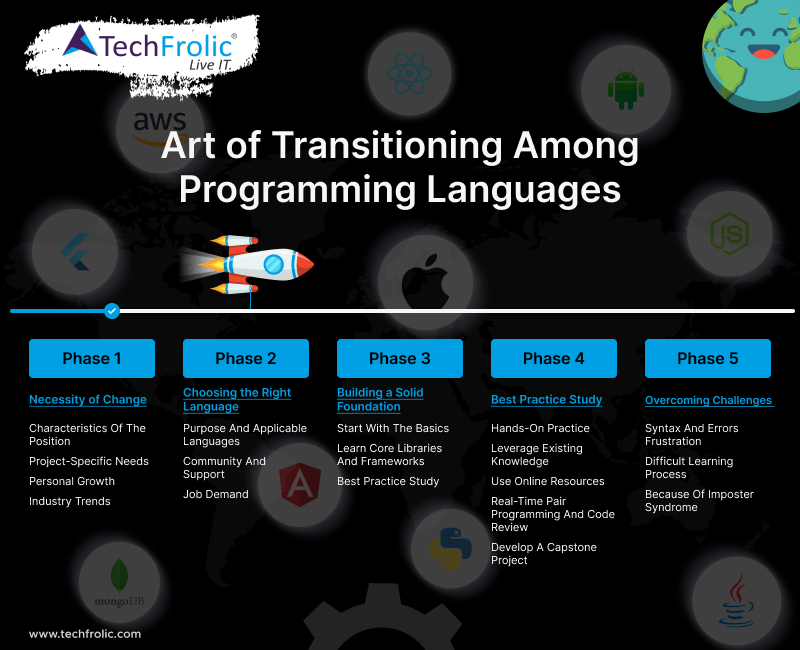Technology is changing at a fast pace, and developers need to master this by switching from one programming language to another. Whether it’s for a new job, a project requirement, or a desire to learn something new and enhance your skills, switching to a different language can be difficult yet beneficial. Here’s a comprehensive guide to help you through this journey smoothly.
1. Necessity of Change: Before we go into the technicalities, the reason should be clear about the change.
- Characteristics of the Position: That could be a requirement for enhanced skills for new position.
- Project-Specific Needs: That could project or client requirements.
- Personal Growth: Learning other languages will enhance your skills.
- Industry Trends: Staying informed about industry trends is always good.
2. Choosing the Right Language: It is very important to consider which language makes the most sense. So, keep in mind the following
- Purpose and Applicable Languages: Every language is good at different things, so it really depends on what you are trying to achieve. For example Python – data science & machine learning and JavaScript – web development.
- Community and Support: Knowing that a language has a vibrant community of users working with it already is an added bonus to learning a new language, as help is at hand. These should have good documentation, forums, and tutorials.
- Job Demand: Find out about the demand for the language in your target market Jobs Market Demand: Research the demand for the language in the job market of your choice. Start with LinkedIn and Indeed, plenty of insights into what employers want.
3. Building a Solid Foundation
- Start with the basics: Learn basic terms and syntax. There are plenty of beginner courses on online platforms like Codecademy, Coursera, and freeCodeCamp.
- Learn Core Libraries and Frameworks: Know all the important libraries and frameworks associated with the language. For example, if you are learning Python, then get some little knowledge on libraries such as NumPy and pandas.
- Best Practice Study: Every language has its own best practices Read up on coding standards, design patterns, and common pitfalls to avoid.
4. Practical Steps for Transitioning
Hands-on Practice: Nothing beats hands-on practice. Start with small projects to apply what you’ve learned
- Mini projects: You can built learning establish, tiny projects, such as, to-do list app, calculator, and simple web scraper.
- Contribute to Open Source: Start contributing to open-source related to your new language. Gives you real-world experience, in the same way making you to follow the best/standard/community practices.
Leverage Existing Knowledge: You will gain from previous programming experience you already have. Understand how concepts translate between languages
- Every language will have its syntax and language, but the core logic is same in all the languages. Concentrate on understanding these differences.
- Common Paradigms: Notice common paradigms such as object-oriented programming (OOP) vs. functional programming. These concepts often carry over with slight variations.
Use Online Resources
- Official documentation — This is the most authoritative source from which you can obtain information. Get in the habit of referencing it often.
- Tutorials and Courses: Websites like Udemy, Pluralsight and Khan Academy provide full courses.
- Community: Participate in forums like Stack Overflow, Reddit, and language-specific communities to seek help and advice.
Real-time Pair Programming and Code Review
- Pair Programming: Work together with a peer who knows the new language well. This can help because you will be able to see how people use and learn from more experienced developers and also receive immediately feedback.
- Code Reviews: Submit your code for peer review, as higher rank experienced developers will guide and critic you. You need constructive criticism for growth.
Develop a Capstone Project
- The capstone project is a bigger, more intricate assignment that integrates your knowledge.
- Select a Relevant Project: Pick a project that makes sense in light of your goals or objectives. It could be a website or a machine learning model.
- Make Process Documentation: During the development process, ensure that all steps are clearly documented. This will help you trace bugs and refer back to particular actions.”
5. Overcoming Challenges: Transitioning to a new language comes with its own set of challenges
- Syntax and Errors Frustration: It’s usual to meet syntax errors and bugs. Perseverance and patience are crucial.
- Difficult Learning Process: Some languages might be hard to understand from scratch. Try to divide learning stages into units that can be easily mastered.
- Because of Imposter Syndrome: Everyone feels like he doesn’t know enough. Remember that every expert was once a beginner. Celebrate small victories along the way.
Conclusion
Switching programming languages is a significant step that can open new doors in your career and enhance your problem-solving abilities. Understanding the need for change, picking the appropriate language, laying a strong foundation, and exploiting available resources you can make this transition successfully. Continue with perseverance and have fun learning something completely different.





